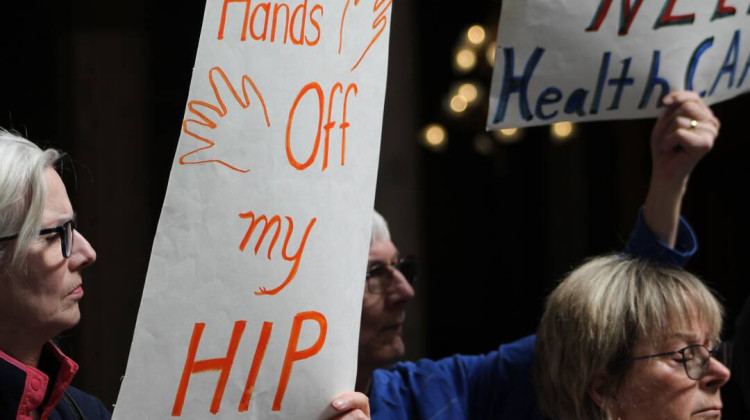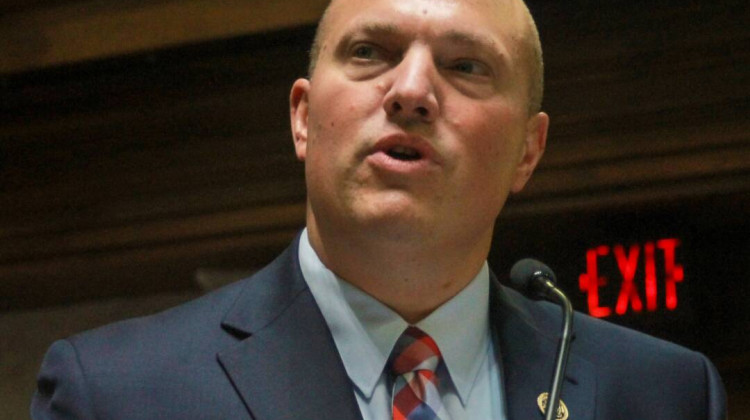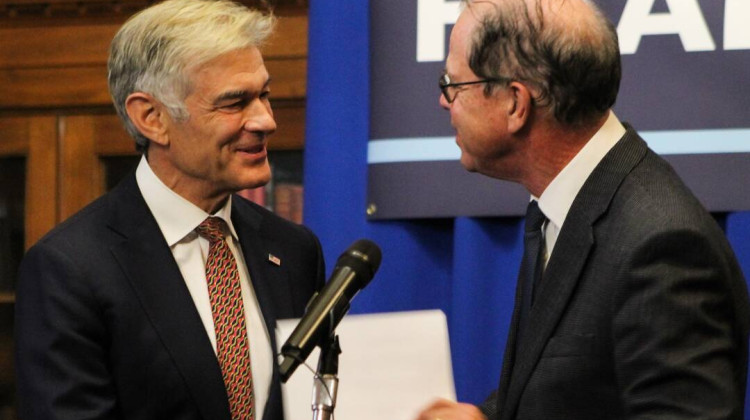
The state will stay in its current phase – Stage 4.5 – for at least another month.
Lauren Chapman/IPB NewsThe Indiana State Department of Health reported 69 additional confirmed deaths over the last week, bringing the state’s total to 3,072. The state announced more than 93,000 total confirmed cases – including two days with more than 1,000 reported cases – and more than 1,065,000 Hoosiers tested.
Holcomb Extends Mask Order, Keeps Indiana In Place On Reopening
Gov. Eric Holcomb is keeping his finger pressed on the pause button for Indiana’s reopening plan.
The state will stay in its current phase – Stage 4.5 – for at least another month. That means, for instance, restaurants can only be at 75 percent capacity, while bars, nightclubs and tourism sites are at 50 percent.
Holcomb said that extension comes even as some of Indiana’s COVID-19 metrics – like the rate at which tests come back positive – are trending down.
“We don’t want that to trend up; we’d like to see it trend down even more so,” Holcomb said.
Indiana Reports 3,000 COVID-19 Deaths
On Saturday, Aug. 22, the Indiana State Department of Health reported its 3,000th confirmed COVID-19 death since March 15.
More than half of those deaths occurred before mid-May. And nearly 60 percent come from long-term care facilities.
While the state’s reported cases have spiked over the last month, reported deaths have – so far – maintained an average of about 10 per day.
With Moratorium Over, Housing Advocates Brace For Eviction 'Tsunami'
Housing advocates are bracing for a “tsunami” of evictions after Indiana lifted its moratorium a little more than a week ago.
There’s no way to know exactly how many evictions have been filed, but a recent study estimates that as many as 720,000 Hoosiers could be at risk.
Indiana’s rental assistance program – which received more than 30,000 applications in just a month – ends Wednesday.
LTHC Homeless Services President and CEO Jennifer Layton said she’s “petrified.”
“We are already in a homeless crisis," Layton said. "We already do not have enough housing for people that are experiencing homelessness.”
Indiana Launches Settlement Program To Keep Evictions Out Of Court
Mediation help is now available to Hoosier landlords and their tenants at risk of eviction, free of charge from the Indiana government.
Both the landlord and renter must agree to the mediation. And the goal is to keep eviction cases out of the courts whenever possible.
Potential settlement outcomes can include payment plans and back payments – but they can also involve eviction. Still, Chief Justice Loretta Rush said keeping the matter out of court can be beneficial.
“Without legal cost and also the stigma that comes along with having an eviction,” Rush said.
Join the conversation and sign up for the Indiana 2020 Two-Way. Text "elections" to 73224. Your comments and questions in response to our weekly text help us find the answers you need on COVID-19 and the 2020 election.
Having an eviction court filing on your record can make it harder to find housing in the future.
Indiana To Create Color-Coded COVID-19 Map To Help Guide School Decisions
The Indiana State Department of Health will launch a map – color-coded based on COVID-19 metrics – that can help guide decision-making at local schools and governments.
State officials have long resisted setting specific parameters for when local schools should open to in-person instruction or shut back down. But State Health Commissioner Dr. Kris Box said the new guidance comes out of repeated pleas for direction.
Each county will have a color – blue, yellow, orange or red – that indicates the severity of COVID-19’s spread. It’s based on a formula of the number of new cases per 100,000 residents, the positivity rate and recent change in that rate.
Businesses Around Speedway Feel The Impact Of An Indy 500 Without Spectators
Japanese IndyCar driver Takuma Sato took the checkered flag to win the 104th running of the Indianapolis 500. But instead of the roar of the crowds to celebrate the moment, it was just the humming of engines.
This year’s race was postponed from May to August in response to COVID-19. Track owner Roger Penske was determined to still have fans, first reducing capacity and then creating a comprehensive health plan.
But Indianapolis Motor Speedway President Doug Boles said ultimately the efforts were just not enough.
“It really just became clear that the metrics weren't going the right way in the city of Indianapolis, and the best thing for us to do as community partners was to have the race without fans,” said Boles.
When the Indy 500 ran without spectators last weekend, it wasn't just the hundreds of thousands of fans who were missing – it was also the millions of dollars they pump into local shops and restaurants. Businesses in the racing capital of the world expect to take a big financial hit this year.
Indiana Won't Allow Expanded Vote-By-Mail This Fall
Indiana Secretary of State Connie Lawson insists the state will have a “normal election” this fall and won’t expand mail-in voting amid the COVID-19 pandemic.
Many Hoosiers – even via lawsuit – have pushed the state to allow anyone to vote by mail for the general election, as Indiana did for its primary. But Republicans, including Lawson, have rejected those pleas.
There are about a dozen reasons you can legally cast a mail-in ballot, including if you’re confined to your home by illness. Lawson said fears over COVID-19 for those in high-risk populations might fall under that provision.
“But if you’re still going to the grocery store and running other errands, you’re not confined to your home,” Lawson said.
NAACP To Help African American Residents With Energy Bills
The NAACP is offering up to $300 for African American residents struggling to pay their energy bills due to COVID-19. This comes about a week after the state allowed utilities to resume disconnections for unpaid bills.
According to a study by Indiana University, a lot of the people who have lost jobs during the pandemic are the same ones who had trouble paying their bills before the crisis — low-income, elderly, African American, and Latino residents.
La'Tonya Troutman is the environmental climate justice chair for the LaPorte County branch of the NAACP. She said, at the same time, people are spending more time at home and it’s hot outside — which is driving those energy bills up even further.
Many people are having to make tough choices between paying for housing, food, and energy.
“What do you prioritize when the governor’s saying, 'Hey, the moratorium’s ended and we're kind of back to normal' — but there is no normal because you're behind?” Troutman said.
Contact Lauren at lchapman@wfyi.org or follow her on Twitter at @laurenechapman_.
 DONATE
DONATE






 Support WFYI. We can't do it without you.
Support WFYI. We can't do it without you.